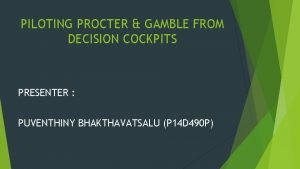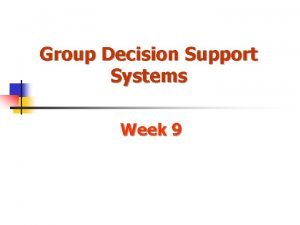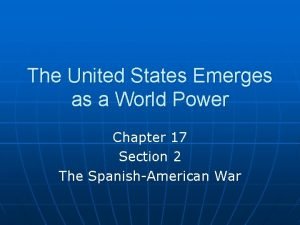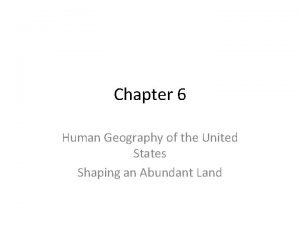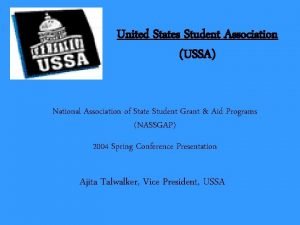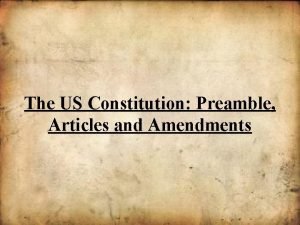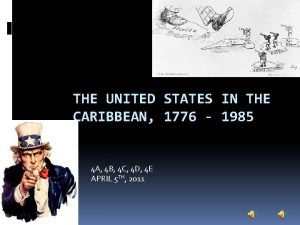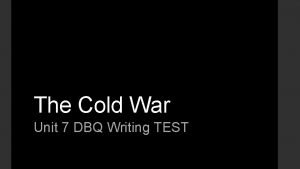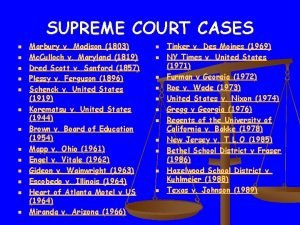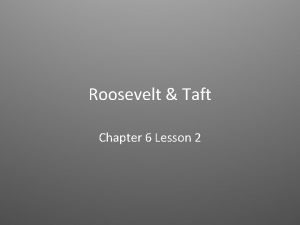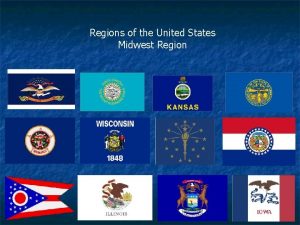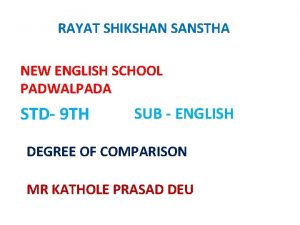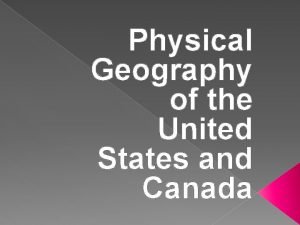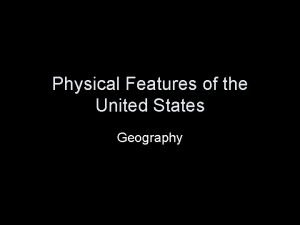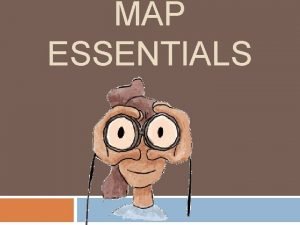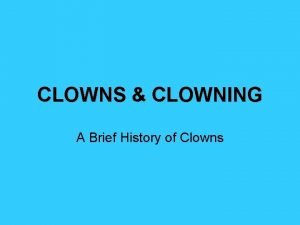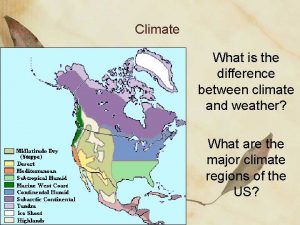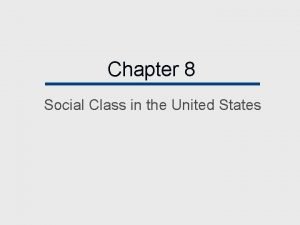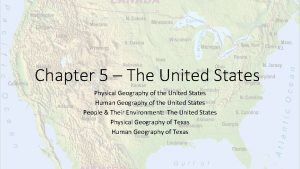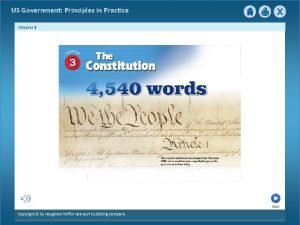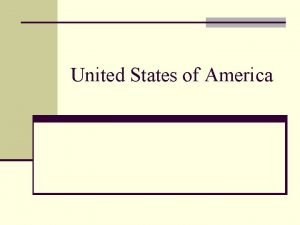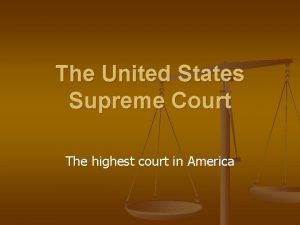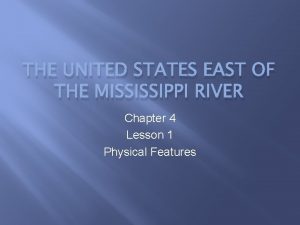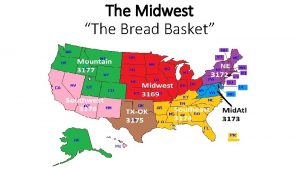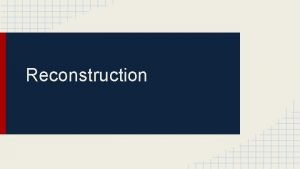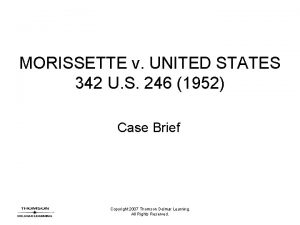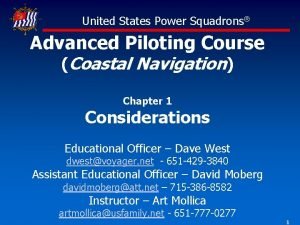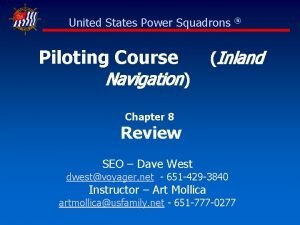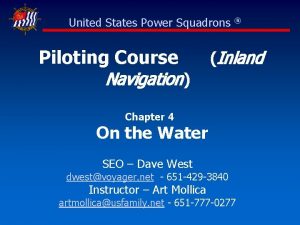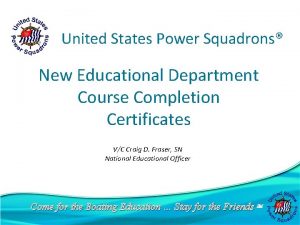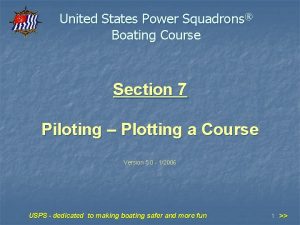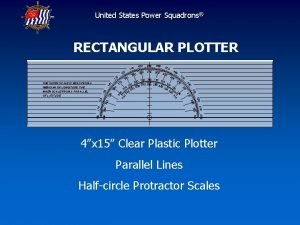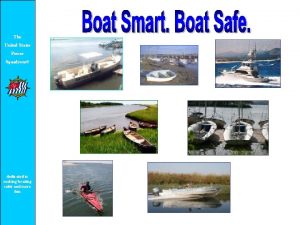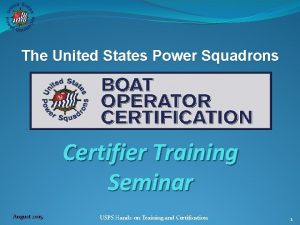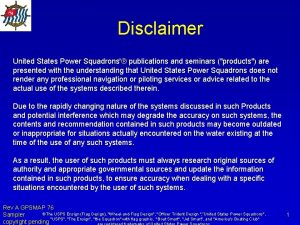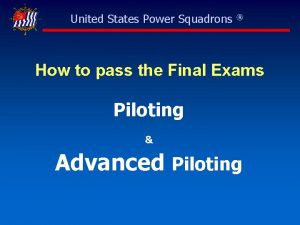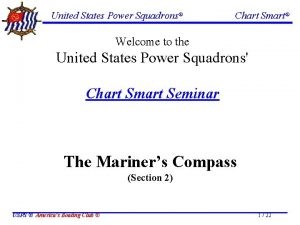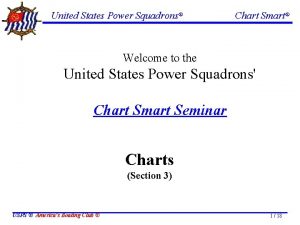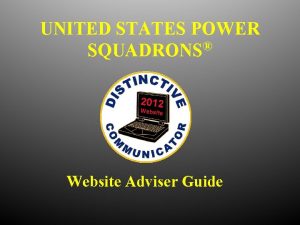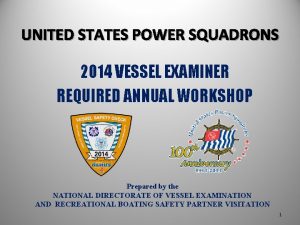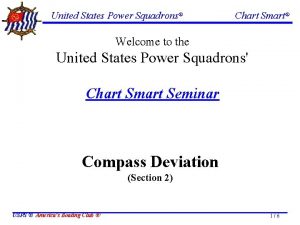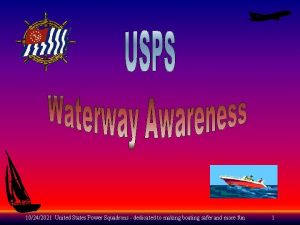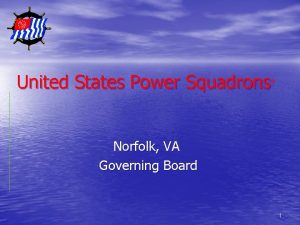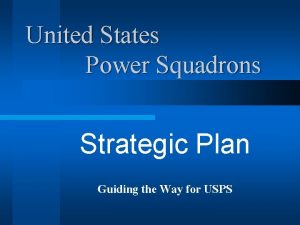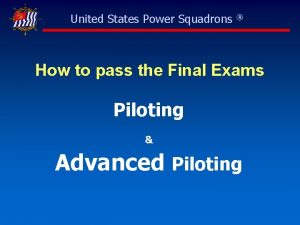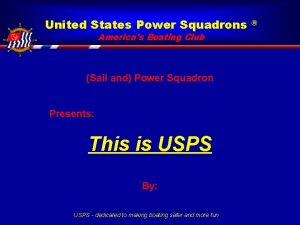United States Power Squadrons Advanced Piloting Course Chapter















































- Slides: 47

United States Power Squadrons ® Advanced Piloting Course Chapter 3 Fixes

Fix Accuracy § Position Accuracy depends upon: • The technique used § GPS § Bearings § Radar • The geometry of the landmarks § Angle between visible landmarks § Shape and orientation of radar targets 2

Fix Accuracy – Bearing Geometry Landmarks close together Landmarks about 90° apart 2° error zone 6

Fix Accuracy – Distance to Landmarks close by Landmarks at a distance 7

Simple Bearings from the Boat 8

Limitations with Visual Bearings § Multiple Bearings § § Often difficult to get simultaneous measurement Landmarks may not be separated sufficiently Landmarks may be too far away Possibly one Landmark § Two Bearings on same Landmark § Sight landmark from different directions § Second bearing somewhat later than first § Called “Running Fix” 9

Running Fix § Why? § When two simultaneous bearings not available § What? § Advance an earlier bearing to overlay your current locale and latest bearing § How? § Use distance run (dead reckoning) to determine how far to advance the first bearing 10

Running Fix 12

Running Fix 13

Running Fix 14

Running Fix 15

Running Fix 16

Running Fix 17

Running Fix 18

Running Fix 19

Running Fix 20

Running Fix 21

Exercise 3 -1 § Take out Bowditch Bay Chart • EXERCISE 3 -1 RUNNING FIX § OBJECTIVE: Using two bearings on the same landmark and advance an LOP to plot a Running Fix. – At 0900, depart R” 2” Fl R 4 s Oyster River on a true course of 355. Speed is 6. 0 Kn. – At 0926, you take a hand bearing compass bearing of 310 on Chapman Point Light. – At 0951, you take a second compass bearing of 260 on Chapman Point Light. – With these two bearings, plot a running fix. – What are the coordinates of the 0951 running fix? – Seaman’s Eye: What can you use to confirm the accuracy of the 0951 fix? – At 0951, you take up a magnetic heading of 099. You increase your speed to 12 Kn. SOLUTION 22

Solution – Exercise 3 -1 23

GPS Fix Accuracy § Basic GPS (no SA) • ~40 ft - - 95% (advertised) • ~33 ft - - typical § WAAS • ~10 ft - - when receiving updates More accurate than any other positioning technique 24

SKILL – Radar Fix § Study Radar returns § Compare with chart § Look for identifiable features • Distinct shorelines • Isolated buoys § Plot • Convert relative bearings before plotting 25

Radar Fix Accuracy § Bearing & Range • Bearing - - 2° typical § 55 ft at short range § 300 ft at medium range § 650 ft at long range • Range - - typical § 30 ft at short range (< ¼ nm) § 75 ft at medium range (< 2 nm) § 200 ft at long range typical (3 nm) 26

Position from Radar Distance to land (VRM 1) Bearing to buoy (EBL 2) Bearing to edge of island (EBL 1) 27

Radar Fix - Buoy 28

Radar Fix – Prominent Feature 29

Radar Fix – Distance Off 30

Radar Images § Buoys are point targets • Challenge: uniquely identifying the buoy § Shoreline echoes are less defined • Shapes change with each sweep • Only see forward slope of shoreline • Low-lying areas may not provide echoes § Look for point features on shoreline • Can get fix § Look for prominent regions • Can get distance from each feature • Fix may be possible – approximate position more likely 31

Exercise 3 -2 – Radar Fix § Take out Bowditch Bay chart • EXERCISE 3 -2 RADAR FIX § OBJECTIVE: Use a radar range and a radar bearing on two objects to plot a radar fix. – You depart RG “CP” Fl(2+1) R 6 s at 0900 on a magnetic heading of 112. Speed is 6. 0 Kn. – At 0950, you take a radar bearing of 357 magnetic from the West end of Dutton Island a radar range of 1. 5 nm from the southernmost coast of Dutton Island. – Use these two lines of position to plot a fix. SOLUTION 32

Exercise 3 -2 Radar Fix 33

Digital Charting

Digital Charting § Digital Charts • Based on Paper Charts • Accuracy based on Scale of Chart • Digital Charts are zoomed § Can lead to false impressions 35

USPS Digital Chart CD § Provided by MAPTECH, Inc. • Chart Navigator Software § Allows planning using digital charts • Sample Charts § Real charts – not for navigation (not updated) § Training charts – Bowditch Bay – 1210 Tr (NOAA training chart) § Included in Course § For your use § Optional material – not graded § Can be used to compare with hand-plotted exercises and cruise 37

Planning a Route on a Computer 47

Waypoint List for Route 48

Quick Route Building enter start and destination route crosses land shortest distance between the two waypoints 49

Adjusting Around Major Obstacles adjust route to avoid land by adding points 50

Scaling In to Refine the Route add more waypoints to refine the path 51

Charts and Photo Charts 53

Refining the Approach to Destination 54

Homework § AP Homework – Chapter 3 • EXERCISE 3 - 2 RUNNING FIX § OBJECTIVE: Using two bearings on two different landmarks and advance an LOP to plot a running fix. – At 1300, depart from a GPS fix of L 41° 45' N and LO 71° 55' W on a true course of 230° and at – a speed of 6. 0 Kn. – At 1330, you take a hand bearing compass bearing on “FI R 6 s horn” of 318°. – At 1355, you take a 2 nd hand bearing compass bearing on “Chapman PT- FI 6 S” of 280°. – With these two bearings, plot and label a running fix at 1355. – What are the two coordinates of the 1355 Rfix? 55

Homework 2 – where are we? using Bowditch Bay chart – based on this screen Where are you? Which are buoys? 56

Questions ? … Comments Homework answers follow --- next week --- 57

Homework Chapter 3 - Solutions

Solution to Exercise 3 -1 59

Demo Homework 1 & 2 SOLUTION 60

Homework Solution 61

62
 Piloting procter & gamble from decision cockpits
Piloting procter & gamble from decision cockpits Piloting procter & gamble from decision cockpits
Piloting procter & gamble from decision cockpits United states acquisitions and annexations 1857-1904
United states acquisitions and annexations 1857-1904 Chapter 2 free enterprise in the united states answer key
Chapter 2 free enterprise in the united states answer key Why is the united states called a postindustrial economy
Why is the united states called a postindustrial economy Chapter 5 lesson 1 physical geography of the united states
Chapter 5 lesson 1 physical geography of the united states Power triangle
Power triangle Was the united states on the axis powers or allied powers?
Was the united states on the axis powers or allied powers? Many _____ people have settled in this megalopolis.
Many _____ people have settled in this megalopolis. Slave state
Slave state Usa pro soccer teams
Usa pro soccer teams United states v. nixon significance
United states v. nixon significance United states student association
United states student association The united states ought to provide a universal basic income
The united states ought to provide a universal basic income What is preamble
What is preamble The united states in the caribbean 1776 to 1985
The united states in the caribbean 1776 to 1985 The southeast region of the united states of america
The southeast region of the united states of america Expansion of the united states of america 1607 to 1853 map
Expansion of the united states of america 1607 to 1853 map Why did truman believe greece needed aid
Why did truman believe greece needed aid Original 13 colonies date acquired
Original 13 colonies date acquired When was awake united states written
When was awake united states written Heart of atlanta motel v. united states
Heart of atlanta motel v. united states We have pacified some thousands of the islanders
We have pacified some thousands of the islanders Chapter 6 lesson 2 guided reading answers
Chapter 6 lesson 2 guided reading answers Nnn
Nnn 7 regions of the united states
7 regions of the united states The united states is the greatest buyer positive degree
The united states is the greatest buyer positive degree United states and canada physical map
United states and canada physical map Physical geography of the united states
Physical geography of the united states World map with latitude and longitude lines
World map with latitude and longitude lines Fifty united states
Fifty united states Perceptual regions of the united states
Perceptual regions of the united states Where do clowns originate from
Where do clowns originate from Subtropical united states
Subtropical united states What are the social classes in the united states
What are the social classes in the united states Physical geography of the united states
Physical geography of the united states Ibn-tamas v. united states
Ibn-tamas v. united states When mr pirzada came to dine character analysis
When mr pirzada came to dine character analysis United states government: principles in practice answers
United states government: principles in practice answers Geographical position of the usa
Geographical position of the usa United states lactation consultant association
United states lactation consultant association Plessy v ferguson summary
Plessy v ferguson summary States east of the mississippi
States east of the mississippi What makes the midwest a breadbasket
What makes the midwest a breadbasket How many states canada
How many states canada United states v. cruikshank apush
United states v. cruikshank apush Morisette v united states
Morisette v united states What is manifest destin
What is manifest destin
